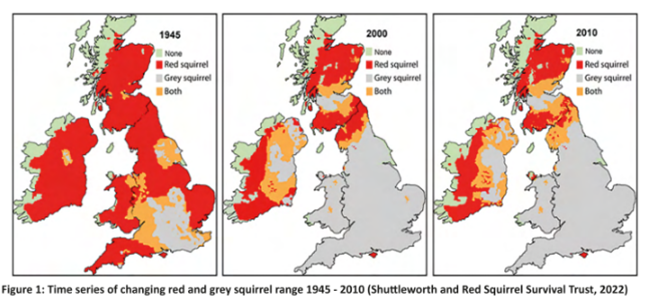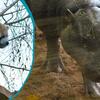With Red Squirrel Awareness Week coming up, Judi Dunn (Animal Registrar, Wildwood Trust) tells us where we are in the story of red squirrel conservation...and how zoos can help:
The red squirrel (Sciurus vulgaris) should feature in everyone’s thoughts thanks to the wonderful story writing and illustrations of Beatrix Potter. However, for the majority of people in England, particularly southern England it is hard to recollect when a person last saw a red squirrel in woodlands or their garden. By the mid-1940s red squirrels were in sharp decline due to the presence of the introduced grey squirrel (Sciurus carolinensis) from North America. These squirrels were released into the British countryside in the late 1800s and found living conditions very favourable. Unfortunately, they out compete for food sources, whilst also exposing red squirrels to the squirrel poxvirus (SQPV) which is fatal. At present in the UK there is approximately 2.5 – 2.7 million grey squirrels and approximately 287,000 red squirrels. 80% of this red squirrel population is in Scotland with small scattered populations in parts of England and Wales and on some islands.

What is being done today:
So with the numbers stacked against them...what are we doing to help our native red squirrel?
Within the BIAZA Native species working group is a small band of people responsible for some of the captive red squirrel collections known as the Red Squirrel Focus Group. We are here to promote best practise in all husbandry, and welfare matters, offer advice and support to all zoological collections who hold red squirrels. There are the Husbandry Management Guidelines offering a huge range of information on how to care for red squirrels in a zoo setting. We also have a studbook keeper who has created and maintains the captive red squirrel studbook. This is a directory of information on all the red squirrels held in collections with details on their parentage. It will ensure the captive population is healthy and genetically robust for any future potential translocations.
In the broader landscape on a national level we collaborate with The UK Squirrel Accord (UKSA) an organisation which acts as an umbrella group for the many regional squirrel organisations, conservation groups, forestry and government agencies. They have spearheaded ongoing research into an effective contraception for grey squirrels which will reduce the breeding and decrease that huge number of greys. They have also pioneered an England Red Squirrel Action Plan which details aims to bring back the wild population of red squirrels to England. They have gone further by being able to research the techniques required to bring these aims into reality. This research is completed and is waiting publication.
Red squirrels need you!
The time has come to investigate our institutional species plans and see if there is a place for our charismatic native mammal on our zoo site. It is a firm favourite with the public who have a connection with native British culture and childhood memories. There is a need to expand the captive population and undertake crucial research to determine the genetic diversity within the population, and baseline health assessments. For when the time is right, the recolonisation of red squirrels into the English countryside will need the input from a healthy, genetic diverse captive population.
- Judi Dunn (Animal Registrar, Wildwood Trust)
All blogs reflect the views of their author and are not necessarily a reflection of BIAZA's position
Related Members
-
News
 Belfast Zoo helps to bring Christmas joy to Children’s Hospital 19th December, 2025Belfast Zoo joined the Lord Mayor of Belfast, Councillor Tracy Kelly, on Monday (15th December) to help bring festive cheer to the Royal Belfast Hospital…
Belfast Zoo helps to bring Christmas joy to Children’s Hospital 19th December, 2025Belfast Zoo joined the Lord Mayor of Belfast, Councillor Tracy Kelly, on Monday (15th December) to help bring festive cheer to the Royal Belfast Hospital… -
News
 Colchester Zoological Society welcomes new arrivals 19th December, 2025This December, Colchester Zoological Society (CZS) welcomed some exciting new arrivals! A young male pygmy hippo, Mikolas, from Zoo Dvur Kralove…
Colchester Zoological Society welcomes new arrivals 19th December, 2025This December, Colchester Zoological Society (CZS) welcomed some exciting new arrivals! A young male pygmy hippo, Mikolas, from Zoo Dvur Kralove… -
News
.png?w=100&h=100&zc=1&f=jpeg&hash=8d175f93cde920c5ba23c8ea7f92e55a) Blog: Understanding the human side of zoos 16th December, 2025Why are zoo researchers increasingly looking to social science? Dr Nieky van Veggel explains the significance of understanding the human dimension…
Blog: Understanding the human side of zoos 16th December, 2025Why are zoo researchers increasingly looking to social science? Dr Nieky van Veggel explains the significance of understanding the human dimension…

.png?w=100&h=50&zc=1&f=jpeg&hash=267b0820c15a001487272fd7ddcd27ed)

